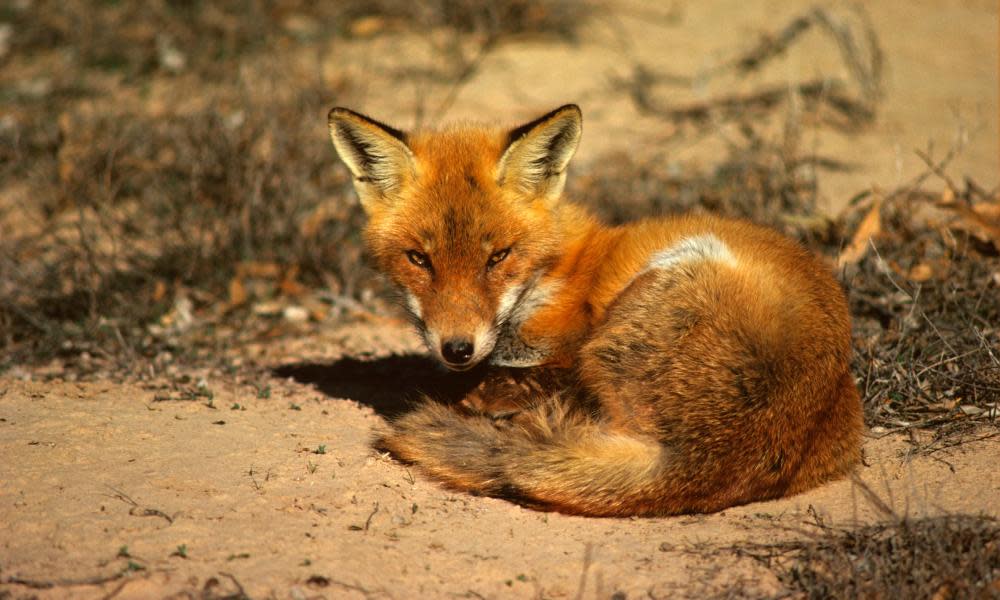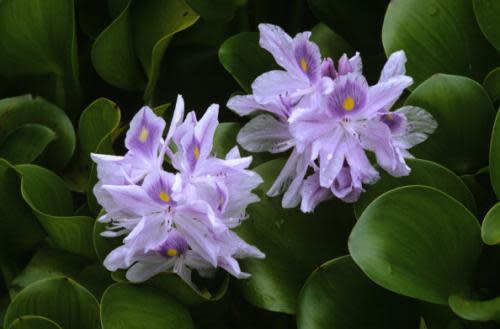'We are clearly losing the fight': scientists sound alarm over invasive species

“We might be the last people on earth to take a sample of an Australian native guava in flower,” says botanist Rod Fensham, as he studies a small cluster of white flowers.
The guava (Rhodomyrtus psidioides) is heading for extinction, says Fensham, of the University of Queensland – but not because of land clearing or climate change. Instead it’s the relentless march of the invasive fungi myrtle rust that will cause its demise.
Myrtle rust is just one example of the invasive pests – weeds, animals and pathogens – that are cutting a swathe through Australia’s unique native flora and fauna.
Research published in September in the Pacific Conservation Biology journal revealed that invasive pests are the No 1 threat to Australia’s most at-risk species – above climate change, land clearing or energy production.
Some 207 invasive plants, 57 animals and three pathogens (including myrtle rust) were affecting 1,257 threatened species.
“Invasives are the major driver of species loss, so if we are worried about extinctions, then we should worry about invasives,” says Andrew Cox, the chief executive of the Invasive Species Council.
“We are clearly losing the fight against invasive species,” says Prof John Woinarski, of Charles Darwin University and the National Environmental Science Program’s threatened species recovery hub.
He says Australia’s history as a large, isolated island means its flora and fauna are “poorly prepared” when invaders come in. When Europeans first arrived in Australia, so did a whole suite of invaders – rabbits, deer, horses, foxes, pigs and cats.
Andy Sheppard, a senior principal research scientist at CSIRO working on invasive species management, says: “That might be a long time ago, but those species spread rapidly and now in Australia foxes and feral cats are driving more native species to extinction than any other impacts.
“As a result, we have a higher extinction rate of native mammals than anywhere else in the world.”
Similarly thousands of exotic plants, some of which were released deliberately to push out native species, were introduced by so-called “acclimatisation societies” and, from the 1920s, the government’s commonwealth plant introduction program. Grasslands and pastoral lands became full of foreign plants and grasses, changing fire regimes.
This problem isn’t confined to history – the invaders keep coming. Sheppard says a new exotic vertebrate establishes in Australia once every five years, with roughly 10 invasive plants establishing each year.
Invasives are the major driver of species loss, so if we're worried about extinction we should worry about invasives.
Andrew Cox, Invasive Species Council
As Australia continues to grow its international trade – through commerce and tourism – the challenge for Australia’s biosecurity system to keep out unwanted plants, animals and pathogens grows ever greater.
Sheppard says there is a broad “rule of 10s” where only one in 10 invaders manages to establish itself in Australia, and only one in 10 of those causes problems.
But those that do hold on can be expensive.
Red fire ants – first detected around the port of Brisbane in 2001 – are considered a multibillion-dollar risk due to their impacts on crops and their ability to put outdoor recreation areas out-of-bounds. The ants are the subject of a $38m-a-year national eradication program but the battle goes on – a new detection was discovered a kilometre outside a “containment zone” in south-east Queensland in May 2018.
Then there are the sleepers, the species that have gone through a “lag phase” – a period when an invasive has established but doesn’t cause a problem, until it does.
“A lot of invasives have gone through that lag phase – they’ll exist at low numbers and then something changes,” says Sheppard, saying periods of drought or good rainfall might be a trigger. “They might then have an increase in the resources they need and then you get that logarithmic growth.”
One example of an invasive emerging from a “lag phase” is the feral deer. Sheppard says it “really took off” in the past decade and is now causing major problems in national parks.
Many of Australia’s more recent exotic weed arrivals start life, says Sheppard, in people’s gardens. Two examples now listed as weeds of national significance are water hyacinths, which were introduced as ornamental plants in garden ponds and lakes; and the Bellyache bush, brought in as a garden plant in the late 1800s.

“They jump the garden fence and, before you know it, they’re in national parks,” Sheppard says.
Making everything more complicated is the march of human-caused climate change, which has the potential to widen the range of some invasives.
A report from the Invasive Species Council found the range of the invasive fox could expand into more alpine areas as temperatures rose. Warming ocean waters off Tasmania have helped invasive sea urchins to extend their range, playing a major role in the disappearance of kelp forests.
Would more funding solve the problem?
A July 2017 review of Australia’s policies on biosecurity, commissioned by state and federal agriculture ministers, warned that while the risks were continuing to build, all budgets to tackle the problem were under “significant pressure”, with funding from governments “static or declining”.
Between 2013-14 and 2015-16, overall government funding for biosecurity fell from $545m to $425m.
The review’s analysis of biosecurity funding found more money was coming from external sources, such as industry or the collection of levies. Over the same period, this reliance on external cash ballooned from $259m to $574m.
The government is trying to raise $108m a year for biosecurity by introducing a $10 levy on shipping containers, but the shipping and logistics industry pushed back when the move was announced in the 2018 federal budget.
The report said volumes of traded goods and arrivals of visitors from overseas were all forecast to increase, in particular from “higher-risk regions”, and likely to make an already bad situation worse.
But throwing money at more biosecurity measures would have only a limited impact on risks to the economy, the report said.
About $90m was spent on biosecurity for four key routes for invasives to enter Australia – air and sea passengers, commercial vessels, sea containers and timber imports.
The federal agriculture department uses a model to work out the benefits of investing in biosecurity measures – known as the risk-return resource allocation model.
We are at crisis point ... Business as usual will see a fast-downward spiral.
Andreas Glanznig, Centre for Invasive Species Solutions
Tripling this $90m investment would still leave Australia exposed to about $2.1bn of risk to the agricultural sector, according to the review’s modelling.
The report said: “This highlights the importance of seeking innovative approaches, pre-border and post-border as well as at the border, to biosecurity risk management; simply increasing funding is not a ‘silver bullet’.”
A national stocktake of biosecurity spending, with figures available from 2013 onwards, does not include spending on research and innovation. When the 2017 review tried to find these numbers, they reported comprehensive data on public investment was “not currently available”.
But Andreas Glanznig, the CEO of the Centre for Invasive Species Solutions, a national research institute that collaborates across governments, agencies and industry, says it will not necessarily be extra funding that makes the difference, but how it is spent.
“We are at crisis point and innovation and new game changing ideas are key to movement. Business as usual will see a fast-downward spiral.”
Among the centre’s research projects are innovations such as using faster DNA techniques to detect invasives, developing “intelligent” traps that can learn to distinguish different species, and understanding if Australia could overcome controversies around the use of so-called “gene drives” that could be deployed against some invasive animals.
Economy v environment
In 2015, Woinarski led research published in leading journal Proceedings of the National Academy of Science that described the “ongoing unravelling” of Australia’s fauna.
The causes were complex, he wrote, but the loss of numerous mammals was “primarily” thanks to feral cats and the European red fox.
“The issue is particularly acute for Australian mammals,” he says. “We have lost 34 in the last 250 years – no other country comes close.”
Getting invasive species under control is critically important because so much of Australia’s wildlife exists nowhere else, he says.
Cox says funding is much more likely to be released if an invasive pest affects a key sector of the economy or a major industry. Environmental impacts such as species loss are not given the same weight.
He says there needs to be a “concerted effort” to tackle invasives, but with an approach that gives more weight to current and potential environmental impacts.
“Biosecurity is usually run from agricultural departments, so there is an inherent bias in the whole system,” he says. “At both state and federal level, the lead agency is usually agriculture, so the problem always tends to be seen through an agricultural lens. We don’t get that environmental thinking.”
Woinarski agrees that when invasive pests do start to cause problems, the level of response tends to be greater if the threat is economic, rather than environmental.
“There’s no doubt about that,” he says. “There’s a much more sustained and well resourced control programs for economic pests, rather than environmental ones.
“Every extinction could have been prevented, but we as a society have failed to give value to our environment.”
Woinarski says with every extinction comes a “profound sense of irretrievable failure”.
“These species have existed for tens of thousands, in some cases millions of years, and many have been successful in responding to everything thrown at them for that time.
“But then, in a very short period of our watch, we have failed.”

 Yahoo News
Yahoo News 
